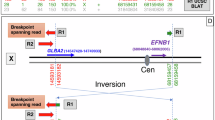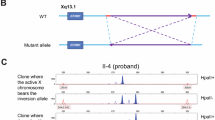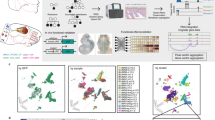Abstract
Craniofrontonasal syndrome (CFNS, MIM 304110) is an X-linked craniofacial disorder that shows paradoxically greater severity in heterozygous females than in hemizygous males. Mutations have been identified in the EFNB1 gene that encodes a member of the ephrin-B family of transmembrane ligands for Eph receptor tyrosine kinases. Here, we describe two unrelated families, in both of which a mother and her son have proven mutations in EFNB1. The mothers have classical features of CFNS; although the sons have no major craniofacial features other than telecanthus, both had a congenital diaphragmatic hernia (CDH). Our cases represent the first in which CDH has been confirmed in males with mutations in EFNB1, highlighting an important role for signalling by ephrin-B1 in the development of the diaphragm.
Similar content being viewed by others
Log in or create a free account to read this content
Gain free access to this article, as well as selected content from this journal and more on nature.com
or
References
Cohen Jr MM : Craniofrontonasal dysplasia. Birth Defects Orig Art Ser 1979; 15: 85–89.
Slover R, Sujansky E : Frontonasal dysplasia with coronal craniosynostosis in three sibs. Birth Defects Orig Art Ser 1979; 15: 75–83.
Grutzner E, Gorlin RJ : Craniofrontonasal dysplasia: phenotypic expression in females and males and genetic considerations. Oral Surg Oral Med Oral Pathol 1988; 65: 436–444.
Kere J, Ritvanen A, Marttinen E, Kaitila I : Craniofrontonasal dysostosis: variable expression in a three-generation family. Clin Genet 1990; 38: 441–446.
Saavedra D, Richieri-Costa A, Guion-Almeida ML, Cohen Jr MM : Craniofrontonasal syndrome: study of 41 patients. Am J Med Genet 1996; 61: 147–151.
Orr DJA, Slaney S, Ashworth GJ, Poole MD : Craniofrontonasal dysplasia. Br J Plast Surg 1997; 50: 153–161.
Cohen Jr MM : Syndromes with craniosynostosis–craniofrontonasal syndrome; in Gorlin RJ, Cohen Jr MM, Hennekam RCM (ed): Syndromes of the Head and Neck. Oxford: Oxford University Press, 2001, pp 981–983.
Twigg SRF, Kan R, Babbs C et al: Mutations of ephrin-B1 (EFNB1), a marker of tissue boundary formation, cause craniofrontonasal syndrome. Proc Natl Acad Sci USA 2004; 101: 8652–8657.
Wieland I, Jakubiczka S, Muschke P et al: Mutations of the ephrin-B1 gene cause craniofrontonasal syndrome. Am J Hum Genet 2004; 74: 1209–1215.
Wieland I, Reardon W, Jakubiczka S et al: Twenty-six novel EFNB1 mutations in familial and sporadic craniofrontonasal syndrome (CFNS). Hum Mutat 2005; 26: 113–118.
Twigg SRF, Matsumoto K, Kidd AMJ et al: The origin of EFNB1 mutations in craniofrontonasal syndrome: frequent somatic mosaicism and explanation of the paucity of carrier males. Am J Hum Genet 2006 (in press).
Compagni A, Logan M, Klein R, Adams R : Control of skeletal patterning by ephrinB1-EphB interactions. Dev Cell 2003; 5: 217–230.
Davy A, Aubin J, Soriano P : Ephrin-B1 forward and reverse signalling are required during mouse development. Genes Dev 2004; 18: 572–583.
Harrison MR, Adzick NS, Estes JM, Howell LJ : A prospective study of the outcome for fetuses with diaphragmatic hernia. JAMA 1994; 271: 382–384.
Witters I, Legius E, Moerman P et al: Associated malformations and chromosomal anomalies in 42 cases of prenatally diagnosed diaphragmatic hernia. Am J Med Genet 2001; 103: 278–282.
Lurie IW : Where to look for the genes related to diaphragmatic hernia? Genet Couns 2003; 14: 75–93.
Slavotinek AM : The genetics of congenital diaphragmatic hernia. Semin Perinatol 2005; 29: 77–85.
Ackerman KG, Herron BJ, Vargas SO et al: Fog2 is required for normal diaphragm and lung development in mice and humans. PLoS Genet 2005; 1: 58–65.
Babiuk RP, Zhang W, Clugston R et al: Embryological origins and development of the rat diaphragm. J Comp Neurol 2003; 455: 477–487.
Hurst J, Baraitser M : Craniofrontonasal dysplasia. J Med Genet 1988; 25: 133–138.
Brooks AS, van Dooren M, Hoogeboom J et al: Congenital diaphragmatic hernia in a female patient with craniofrontonasal syndrome. Clin Dysmorphol 2002; 11: 151–153.
McGaughran J, Rees M, Battin M : Craniofrontonasal syndrome and diaphragmatic hernia. Am J Med Genet 2002; 110: 391–392.
Morris CA, Palumbos JC, Carey JC : Delineation of the male phenotype in craniofrontonasal syndrome. Am J Med Genet 1987; 27: 623–631.
Nikolov DB, Li C, Barton WA, Himanen JP : Crystal structure of the ephrin-B1 ectodomain: implications for receptor recognition and signaling. Biochemistry 2005; 44: 10947–10953.
Flenniken AM, Gale NW, Yancopoulos GD, Wilkinson DG : Distinct and overlapping expression patterns of ligands for Eph-related receptor tyrosine kinases during mouse embryogenesis. Dev Biol 1996; 179: 382–401.
Baker RK, Antin PB : Ephs and ephrins during early stages of chick embryogenesis. Dev Dyn 2003; 228: 128–142.
Acknowledgements
We are very grateful to the families for their participation in this work. The mutation analysis described in this work was funded by the Wellcome Trust (AOMW).
Author information
Authors and Affiliations
Corresponding author
Rights and permissions
About this article
Cite this article
Vasudevan, P., Twigg, S., Mulliken, J. et al. Expanding the phenotype of craniofrontonasal syndrome: two unrelated boys with EFNB1 mutations and congenital diaphragmatic hernia. Eur J Hum Genet 14, 884–887 (2006). https://doi.org/10.1038/sj.ejhg.5201633
Received:
Revised:
Accepted:
Published:
Issue date:
DOI: https://doi.org/10.1038/sj.ejhg.5201633
Keywords
This article is cited by
-
Phenotypes of craniofrontonasal syndrome in patients with a pathogenic mutation in EFNB1
European Journal of Human Genetics (2014)
-
Examination of FGFRL1 as a candidate gene for diaphragmatic defects at chromosome 4p16.3 shows that Fgfrl1 null mice have reduced expression of Tpm3, sarcomere genes and Lrtm1 in the diaphragm
Human Genetics (2010)



